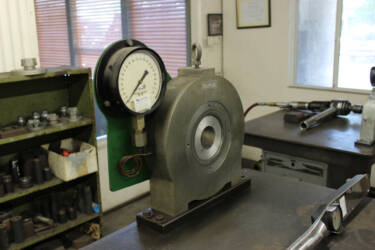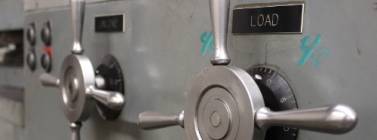Which bolts require a rotational capacity test?
 The rotational capacity test, sometimes referred to as a ROCAP test or RC test, serves as a quality control measure against excessively over-tapped nuts, a material with insufficient ductility, and generally assures that the assembly of elements (bolt, nut, and washer) will function together as a unit to achieve the required preloads. The test intends to evaluate the presence and efficiency of a lubricant and the compatibility of assemblies. The rotational capacity test is performed with a torque wrench and a Skidmore Wilhelm bolt tension measuring device.
The rotational capacity test, sometimes referred to as a ROCAP test or RC test, serves as a quality control measure against excessively over-tapped nuts, a material with insufficient ductility, and generally assures that the assembly of elements (bolt, nut, and washer) will function together as a unit to achieve the required preloads. The test intends to evaluate the presence and efficiency of a lubricant and the compatibility of assemblies. The rotational capacity test is performed with a torque wrench and a Skidmore Wilhelm bolt tension measuring device.
Each test will require the assembly to reach a minimum rotation to sufficiently pass the rotational capacity test. The table below provides the minimum rotation required for the assembly to ensure full functionality and tension for the designated lengths of bolts.
| Bolt Length Required Rotation |
Up to 4D | >4D to 8D | >8D to 12D |
|---|---|---|---|
| 120 ksi (830 MPa) min | 240° | 360° | 420° |
| 150 ksi (1040 MPa) min | 240° | 300° | 360° |
When the F3125 specification was first written, a rotational capacity test was a supplementary requirement. A recent 2019 revision to the F3125 specification has shifted the rotational capacity test back to a required test for galvanized F3125 Grade A325 assemblies that include a nut and washer, to be performed by the manufacturer or responsible party. The rotational capacity test may also be requested by the purchaser to be administered on other structural grades such as A490, or other coated and plain assemblies that must be fully pre-tensioned under supplementary requirement S4.
An important exception to the rotational capacity testing requirement is that bolts more than 12 times diameters in length are exempt. Additionally, structural bolts between 8 and 12 diameters in length or bolts with extended thread lengths are extremely susceptible to rotational capacity testing failure.




Hi Dane,
Thanks for following up. This slipped off my radar for a bit.
For the sake of making everyone happy, our internal practice now prohibits the use of extra washers to make up the space.
If we plan correctly, it shouldn’t be a problem.
Thanks again.
Dane, thank you for your reply. Without trying to argue too much, F3125, Appendix A, A2.5.2.1 says:
Install the bolt and any required spacers in the tension measuring device so that the bolt stick-out is flush with the nut to a maximum of three threads stick-out. This will typically provide three to five threads within the grip.
The 2005 FWHA Document (Procedures for Performing Rotational Capacity Test) says:
Install the bolt in the tension calibrator with the required spacers or washers so that the bolt stick-out is flush with the nut to a maximum of three threads. This will typically provide three to five threads within the grip, the distance between the bolt head and the inside face of the nut. This same stick-out requirement applies during installation.
You will note the FHWA specifically says …required spacers “or washers”…, while the direction in F3125 eliminates the words “or washers”.
We recently got questioned on our practice, which has been based on the FHWA guidance. Since it looks like stacking washers was eliminated from F3125, we are trying to determine if it was eliminated on purpose.
@Charles- I guess the question would be what is the difference between a washer and a spacer? A washer in this case is obviously an F436 SAE patterned washer, but can a washer be used as a spacer? I don’t see where the word spacer is defined and so I’d say it is a bit vague. Why the word was eliminated I do not know. When the procedure was written, the idea was to combine and standardize the procedure since there were differences between the then several procedures in existence. I cannot conclusively say that the word ‘or washers’ was taken out on purpose or if the author was just trying for brevity.
ASTM F3125 discusses using “spacers” when conducting long bolt tests. The now archived FHWA Rotational Capacity Test procedure used to allow the use of “washers or spacers” to make sure no more than three threads are exposed above the nut.
Is the use of more than one washer allowed, or must the test be done with one washer and a single or multiple spacers below the washer?
@Charles- The F3125 standard references washers and spacers, but we see no reason why a washer cannot be used as a spacer if needed. We’d probably not want to use multiple washers, since the inherent gaps when stacking multiple washers together may compress during tensioning and not give a satisfactory result.
what is the minimum testing percentage of assemblies required per lot ?
@Les- It isn’t a linear sample size. The sampling chart can be found in ASTM F1470.
In the article it was never explained how the test is performed, or what is actually measured during the test, or what constitutes “failure” of the test.
@Brian- The procedures are detailed in the F3125 standard. There are minimum tension requirements, maximum torque requirements, and the bolt must not break,. Additionally, the bolt and nut must not deform to the point that the nut will not easily thread on and off of the bolt. Essentially what you are testing is the ability of the joint to perform and required.